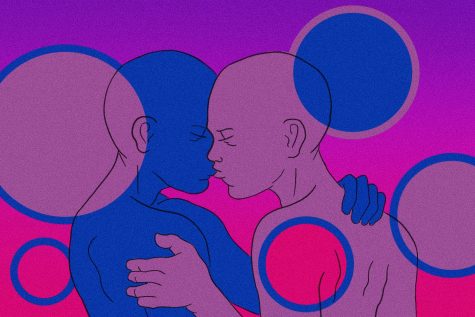‘Seeing that hatred or that disgust or the attempt to erase bisexuals is difficult’: The harmful effects of bi-erasure
February 8, 2022

Khai Howard-Nance’s road to accepting her bisexuality was anything but an easy one, describing it as a “constant journey.”
Howard-Nance, a sophomore acting major, has been dealing with the struggles that come from biphobia ever since she was a preteen.
“I still sometimes feel insecure in my sexuality or feel like maybe I am just straight,” she said. “Even though I know that I’m not, hearing so many things from outside sources … seeing that hatred or that disgust or the attempt to erase bisexuals is difficult. You do kind of start to internalize it.”
Even though they make up 52% of the LGBTQ+ community, it’s common for bisexual people to hear comments in their daily life, such as, “They’re just confused — they’re either gay or lesbian, and this is a transition phase until they come out,” “They’re actually straight, but they want the attention,” or “It’s not even real.”
Statements like these are an example of bi-erasure, the attempt to ignore or deny the existence and legitimacy of the sexuality.
Britta Larson, the senior services director at the Center on Halsted, who is also bisexual, said biphobia can be especially harmful because of the higher rates of depression, anxiety, domestic violence and lower incomes already imposed on people who are bisexual.
According to an article by the Harvard Health Blog, bisexual people are more likely to also experience higher rates of gastrointestinal problems, arthritis and obesity than their monosexual peers, with women specifically struggling with health-related quality of life and men with high cholesterol, high blood pressure and cardiovascular disease, all of which can stem from minority stress.
“There’s a direct relationship to the stigma and the shame that is being attached to being bisexual and that erasure and that invisibility and people really denying that as a true sexual orientation and a true identity,” Larson said. “All those myths and jokes are not funny, and they have an impact on the bi community.”
Emphasizing the importance of educating individuals, the Center on Halsted offers resources, such as STD testing and hotlines and an anti-violence project that helps to support LGBTQIA+ individuals who are “survivors of hate and bias violence, discrimination, intimate partner violence, stalking and/or sexual assault.” In order to specifically support the bisexual community, they hosted a panel discussion for Bi Visibility Day in 2020, which takes place Sept. 23 each year, with presentations and an open Q&A session on Facebook Live.
Elias Packard, a senior clinical psychology major at the University of Illinois at Urbana-Champaign, said he first found out he was bisexual when he was 15, saying he looked at both men and women “with the same star-eyes.”
Having experienced biphobia firsthand from his own friends, Packard recalls feelings of reluctance to come out fully after getting made fun of or questioned by peers — further causing him to deal with internalized biphobia.
Packard talked about hearing straight male friends make gay jokes and having women question the intent of his friendships with other guys.
“It was pretty hard at times because it really makes you question your identity if you have feelings and then they’re not being validated by the people you care about,” Packard said. “It’s really difficult to have a strong sense of identity.”
Jude Ramirez, a junior communication major, first discovered their bisexuality through a threesome. Prior to that, they had often questioned if they were just straight or lesbian and consequently dealt with imposter syndrome. Ramirez also struggled with being hypersexualized and said it was dehumanizing, especially when being viewed through the male gaze. They said their sexuality did not define them as being overtly sexually promiscuous.
“It’s just hilarious to me that so many people are so close-minded about the fact that there is something else besides being straight,” Ramirez said. “I feel like straightness is just the norm, and I hate it because straightness is what keeps the patriarchy alive. When people are trying — especially white cisgender men — when they try to think their way of existing is the only way, it makes me laugh out of frustration.”
Ramirez also said they experienced internalized biphobia early on in their journey to coming to terms with their bisexuality. In middle school, they were told that bisexuality was not real and they had to be attracted to one gender. At around 18 years old, they became more comfortable with accepting their bisexuality, especially after enrolling at Columbia and meeting peers with similar experiences to theirs.
“I’m really happy to be surrounded by more people who are … [not] just heterosexual white people, because that was a big demographic that I was surrounded by for a long time,” Ramirez said. “It’s just nice to finally not be a part of that and get more exposure to different ways of living, and I feel like Columbia has a great plethora of queer people that are so open and willing to speak about their own experiences and are very happy to be in this environment.”







